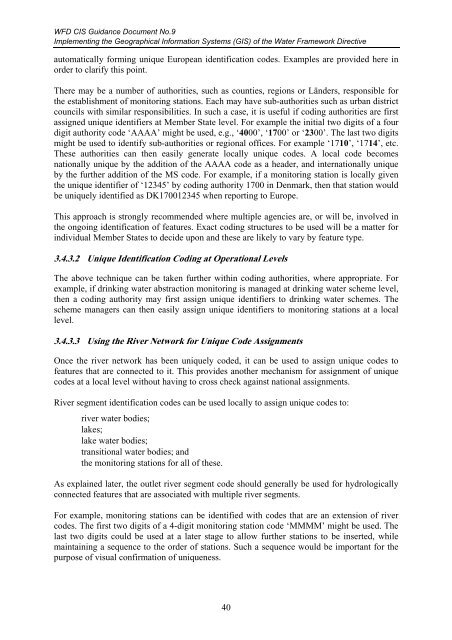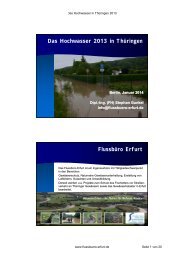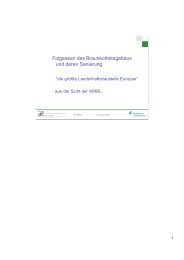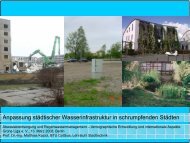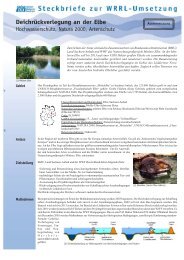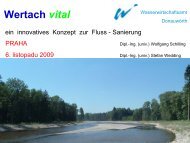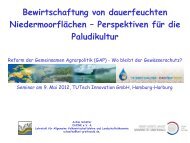Common Implementation Strategy for the Water Framework Directive
Common Implementation Strategy for the Water Framework Directive
Common Implementation Strategy for the Water Framework Directive
You also want an ePaper? Increase the reach of your titles
YUMPU automatically turns print PDFs into web optimized ePapers that Google loves.
WFD CIS Guidance Document No.9<br />
Implementing <strong>the</strong> Geographical In<strong>for</strong>mation Systems (GIS) of <strong>the</strong> <strong>Water</strong> <strong>Framework</strong> <strong>Directive</strong><br />
automatically <strong>for</strong>ming unique European identification codes. Examples are provided here in<br />
order to clarify this point.<br />
There may be a number of authorities, such as counties, regions or Länders, responsible <strong>for</strong><br />
<strong>the</strong> establishment of monitoring stations. Each may have sub-authorities such as urban district<br />
councils with similar responsibilities. In such a case, it is useful if coding authorities are first<br />
assigned unique identifiers at Member State level. For example <strong>the</strong> initial two digits of a four<br />
digit authority code ‘AAAA’ might be used, e.g., ‘4000’, ‘1700’ or ‘2300’. The last two digits<br />
might be used to identify sub-authorities or regional offices. For example ‘1710’, ‘1714’, etc.<br />
These authorities can <strong>the</strong>n easily generate locally unique codes. A local code becomes<br />
nationally unique by <strong>the</strong> addition of <strong>the</strong> AAAA code as a header, and internationally unique<br />
by <strong>the</strong> fur<strong>the</strong>r addition of <strong>the</strong> MS code. For example, if a monitoring station is locally given<br />
<strong>the</strong> unique identifier of ‘12345’ by coding authority 1700 in Denmark, <strong>the</strong>n that station would<br />
be uniquely identified as DK170012345 when reporting to Europe.<br />
This approach is strongly recommended where multiple agencies are, or will be, involved in<br />
<strong>the</strong> ongoing identification of features. Exact coding structures to be used will be a matter <strong>for</strong><br />
individual Member States to decide upon and <strong>the</strong>se are likely to vary by feature type.<br />
3.4.3.2 Unique Identification Coding at Operational Levels<br />
The above technique can be taken fur<strong>the</strong>r within coding authorities, where appropriate. For<br />
example, if drinking water abstraction monitoring is managed at drinking water scheme level,<br />
<strong>the</strong>n a coding authority may first assign unique identifiers to drinking water schemes. The<br />
scheme managers can <strong>the</strong>n easily assign unique identifiers to monitoring stations at a local<br />
level.<br />
3.4.3.3 Using <strong>the</strong> River Network <strong>for</strong> Unique Code Assignments<br />
Once <strong>the</strong> river network has been uniquely coded, it can be used to assign unique codes to<br />
features that are connected to it. This provides ano<strong>the</strong>r mechanism <strong>for</strong> assignment of unique<br />
codes at a local level without having to cross check against national assignments.<br />
River segment identification codes can be used locally to assign unique codes to:<br />
�� river water bodies;<br />
�� lakes;<br />
�� lake water bodies;<br />
�� transitional water bodies; and<br />
�� <strong>the</strong> monitoring stations <strong>for</strong> all of <strong>the</strong>se.<br />
As explained later, <strong>the</strong> outlet river segment code should generally be used <strong>for</strong> hydrologically<br />
connected features that are associated with multiple river segments.<br />
For example, monitoring stations can be identified with codes that are an extension of river<br />
codes. The first two digits of a 4-digit monitoring station code ‘MMMM’ might be used. The<br />
last two digits could be used at a later stage to allow fur<strong>the</strong>r stations to be inserted, while<br />
maintaining a sequence to <strong>the</strong> order of stations. Such a sequence would be important <strong>for</strong> <strong>the</strong><br />
purpose of visual confirmation of uniqueness.<br />
40


